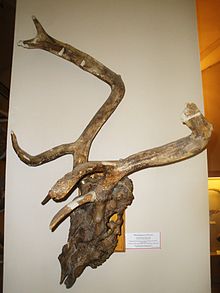
A deer or true deer is a hoofed ruminant ungulate of the family Cervidae. It is divided into subfamilies Cervinae and Capreolinae. Male deer of almost all species, as well as female reindeer, grow and shed new antlers each year. These antlers are bony extensions of the skull and are often used for combat between males.

The Irish elk, also called the giant deer or Irish deer, is an extinct species of deer in the genus Megaloceros and is one of the largest deer that ever lived. Its range extended across Eurasia during the Pleistocene, from Ireland to Lake Baikal in Siberia. The most recent remains of the species have been radiocarbon dated to about 7,700 years ago in western Russia. Its antlers, which can span 3.5 metres (11 ft) across are the largest known of any deer. It is not closely related to either living species called the elk, with it being widely agreed that its closest living relatives are fallow deer (Dama).

Megaloceros is an extinct genus of deer whose members lived throughout Eurasia from the Pleistocene to the early Holocene. The type and only undisputed member of the genus, Megaloceros giganteus, vernacularly known as the "Irish elk" or "giant deer", is also the best known. Fallow deer are thought to be their closest living relatives. Megaloceros is thought to be closely related to the East Asian genus Sinomegaceros, as well as possibly other extinct genera of "giant deer".

Eucladoceros is an extinct genus of large deer whose fossils have been discovered across Eurasia, from Europe to China, spanning from the Late Pliocene-Early Pleistocene. It is noted for its unusual comb-like or branching antlers.
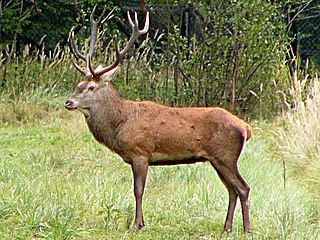
Cervus is a genus of deer that primarily are native to Eurasia, although one species occurs in northern Africa and another in North America. In addition to the species presently placed in this genus, it has included a whole range of other species now commonly placed in other genera. Additionally, the species-level taxonomy is in a state of flux.
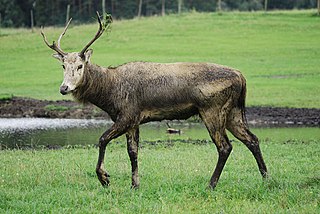
The Cervinae or the Old World deer, are a subfamily of deer. Alternatively, they are known as the plesiometacarpal deer, due to having lost the parts of the second and fifth metacarpal bones closest to the foot, distinct from the telemetacarpal deer of the Capreolinae.

The Sardinian dhole is an extinct insular canid which was endemic to what is now the Mediterranean islands of Sardinia and Corsica during the Middle-Late Pleistocene. It went extinct at the end of the Pleistocene around the time of human settlement of the islands.

Candiacervus is an extinct genus of deer native to Pleistocene Crete. Due to a lack of other herbivores, the genus underwent an adaptive radiation, filling niches occupied by other taxa on the mainland. Due to the small size of Crete, some species underwent insular dwarfism, the smallest species, C. ropalophorus, stood about 40 centimetres (16 in) at the shoulders when fully grown, while other species were relatively large and comparable in size to mainland deer species. Some species are noted for their peculiar, elongate club-shaped antlers, though other species have more normal antlers.

The Philippine deer, also known as the Philippine sambar or Philippine brown deer, is a vulnerable deer species endemic to the Philippines. It was first described from introduced populations in the Mariana Islands, hence the specific name.
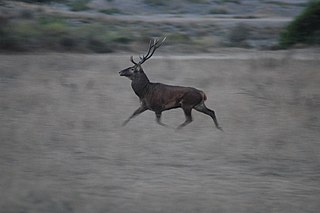
The Corsican red deer, also known simply as the Corsican deer or Sardinian deer, is a subspecies of red deer found on the Mediterranean islands of Sardinia (Italy) and Corsica (France).

The Finnish forest reindeer(Rangifer fennicus fennicus, also known as Eurasian or European forest reindeer is a rare subspecies of the reindeer native to Finland and northwestern Russia. They are found primarily in Russian Karelia and the provinces of North Karelia, Savonia and Kainuu in Finland, though some range into central south Finland. They are distinct from the semi-domesticated mountain reindeer in their larger size, longer legs and preference for dense boreal forest habitat, where they are rarely seen by humans, over the open tundra. The Finnish herd migrates seasonally back and forth across the long Russo-Finnish border.
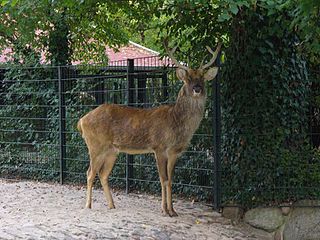
Rucervus is a genus of deer from India, Nepal, Indochina, and the Chinese island of Hainan. The only extant representatives, the barasingha or swamp deer and Eld's deer, are threatened by habitat loss and hunting; another species, Schomburgk’s deer, went extinct in 1938. Deer species found within the genus Rucervus are characterized by a specific antler structure, where the basal ramification is often supplemented with an additional small prong, and the middle tine is never present. The crown tines are inserted on the posterior side of the beam and may be bifurcated or fused into a small palmation.

Cervalces latifrons, the broad-fronted moose, or the giant moose was a giant species of deer that inhabited the Europe and Asia during the Pleistocene epoch. It is thought to be the ancestor of the modern moose, as well as the extinct North American Cervalces scotti. It was considerably larger than living moose, placing it as one of the largest deer to have ever lived.

Talpa tyrrhenica, also known as the Tyrrhenian mole, is an extinct species of mole belonging to the genus Talpa. It was endemic to the Mediterranean islands of Corsica and Sardinia during the Pleistocene epoch.
Agalmaceros is a potentially invalid extinct genus of deer of the Cervidae family, that lived in South America during the Pleistocene. The only species currently known is A. blicki. Remains have only been found in Ecuador. It showed a clear affinity to Andean or temperate habitats. Agalmaceros blicki is estimated to have been 60 kilograms (130 lb) in weight.

Megaceroides algericus is an extinct species of deer known from the Late Pleistocene to the Holocene of North Africa. It is one of only two species of deer known to have been native to the African continent, alongside the Barbary stag, a subspecies of red deer. It is considered to be closely related to the giant deer species of Eurasia.

Sinomegaceros is an extinct genus of deer known from the Late Pliocene/Early Pleistocene to Late Pleistocene of Central and East Asia. It is considered to be part of the group of "giant deer", with a close relationship to Megaloceros. Many members of the genus are noted for their distinctive palmate antler brow tines.

Enhydrictis is a genus of extinct mustelid, belonging to the subfamily Galictinae. The type species, and best known, is Enhydrictis galictoides from the Pleistocene of Sardinia and Corsica. Some authors attribute species from mainland Eurasia to the genus, but this is disputed, with others considering the genus endemic to Sardinia-Corsica.

Cervus astylodon, the Ryukyu dwarf deer, is an extinct species of dwarf deer that was endemic to the Ryukyu Islands of Okinawa, Ishigaki, Kume and Tokunoshima. It lived throughout the Pleistocene, becoming extinct towards the end of the Late Pleistocene, following the arrival of humans to the Ryukyu Islands.
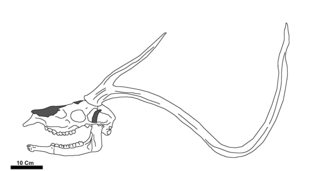
Haploidoceros is an extinct genus of deer that lived in Europe during the Pleistocene. It contains a single species, Haploidoceros mediterraneus. It had a distribution limited to southern France and the Iberian peninsula.
